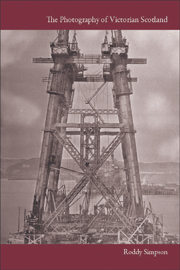Book contents
- Frontmatter
- Contents
- List of Figures
- Introduction
- 1 The Origins of Scottish Photography: Pioneering Activities in St Andrews and Edinburgh
- 2 David Octavius Hill and Robert Adamson: the ‘Partnership of Genius’ and the First Art Photography
- 3 Photography for the Few: The Activities of the Enthusiastic and Artistic Amateurs
- 4 Photography in Demand: The Work of the Increasing Number of Professional Photographers to Meet Public Demand
- 5 Scots Abroad: The Achievements of Scottish Photographers Around the World
- 6 Tourists and Travellers: Images of Scotland Produced for the Rapidly Growing Tourist Market and Photographs Taken by Visitors
- 7 Recording Social Conditions and Industrial Change: Photographs of what was Being Lost and what was Replacing it
- 8 Photography as Art: Looking at the Images and the Arguments
- 9 Populist Activity and Pictorialism: Popular Involvement with Cheap and Mass Produced Cameras and Photographers with Artistic Aspirations
- 10 Scotland's Enduring Photographic Legacy
- Bibliography
- Acknowledgements
- Index
5 - Scots Abroad: The Achievements of Scottish Photographers Around the World
Published online by Cambridge University Press: 05 August 2013
- Frontmatter
- Contents
- List of Figures
- Introduction
- 1 The Origins of Scottish Photography: Pioneering Activities in St Andrews and Edinburgh
- 2 David Octavius Hill and Robert Adamson: the ‘Partnership of Genius’ and the First Art Photography
- 3 Photography for the Few: The Activities of the Enthusiastic and Artistic Amateurs
- 4 Photography in Demand: The Work of the Increasing Number of Professional Photographers to Meet Public Demand
- 5 Scots Abroad: The Achievements of Scottish Photographers Around the World
- 6 Tourists and Travellers: Images of Scotland Produced for the Rapidly Growing Tourist Market and Photographs Taken by Visitors
- 7 Recording Social Conditions and Industrial Change: Photographs of what was Being Lost and what was Replacing it
- 8 Photography as Art: Looking at the Images and the Arguments
- 9 Populist Activity and Pictorialism: Popular Involvement with Cheap and Mass Produced Cameras and Photographers with Artistic Aspirations
- 10 Scotland's Enduring Photographic Legacy
- Bibliography
- Acknowledgements
- Index
Summary
The outstanding enterprise, endeavour and ability of Scottish photographers finds graphic demonstration in the achievements of those who worked outside of Scotland. It is a trend in Scottish history, which continues, that Scotland has exported throughout the world individuals of talent and expertise who have enjoyed success and recognition in their chosen profession. In the Victorian period this was the case with a rich abundance of exceptional Scottish photographers. They made their mark wherever they went, achieving notable firsts and leading where others would follow.
The most prominent was John Thomson who gained an international reputation and created pioneering images in the Far East, England and Cyprus. There was William Carrick in Russia, Robert Macpherson in Italy and several Scots working in India. In the USA there was Alexander Gardner and William Notman in Canada. There were others in China, Japan, Australia, New Zealand and Africa. There were in fact too many Scottish photographers working abroad to include them all in this chapter. Another aspect of photographic involvement abroad was the increasing number of Scottish tourists, who travelled widely and collected photographs by local photographers of the places they visited.
The status and prestige of Scottish photographers can be encapsulated in two photographs. One is of Abraham Lincoln, President of the Union in the American Civil War, shortly before his assassination. It is a powerful image, showing in his gaunt lined face the toll the war had taken. The other is Jefferson Davis, President of the Confederate States, shown with his wife in a sumptuous and dignified studio portrait.
- Type
- Chapter
- Information
- The Photography of Victorian Scotland , pp. 90 - 114Publisher: Edinburgh University PressPrint publication year: 2012

